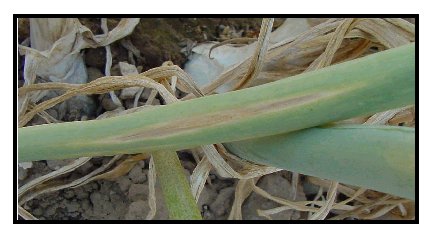Newsletter Archives |
August/September 2004 Newsletter
Lindsey du Toit and Debra Inglis, editorsWSU Mount Vernon NWREC
16650 State Rte 536, Mount Vernon, WA 98273-4768
360-848-6140 (tel), 360-848-6159 (fax)
WSU Vegetable Pathology Team Newsletter
IN THIS ISSUE
- Greetings, farewells, & updates!
- Vegetable events and announcements
- IYSV increasing in prevalence in onion bulb & seed crops in the Columbia Basin
- Recent research publications of WSU Vegetable Pathology Team members
- 2004 Sweet Corn Seed Treatment Trial
- WSU Carrot Cultivar Evaluations
- 2003 Onion Varietal & Storage Demonstration Trials
GREETINGS AND UPDATES
Welcome
to the August/September 2004 newsletter of the WSU Vegetable Pathology
Team. Vegetable cultivar trials are the focus of this issue of the
newsletter, with reports on onion and sweet corn provided by Gary
Pelter, WSU Extension Educator for Grant/Adams Counties, and on
carrot provided by Erik Sorensen, WSU Extension Educator for Franklin
County.
The WSU Vegetable Pathology Team wishes to express much appreciation
and thanks to Gary Pelter and Erik Sorensen, both of whom will be
retiring in the next year: Erik Sorensen on October 1st , 2004,
and Gary Pelter on March 1st, 2005. We are saddened to see them
leave the Team and WSU, but appreciative of their tremendous effort
and impact on the vegetable industry in Washington and the greater
Pacific Northwest. Gary and Erik each have contributed 25+ years
to extension. Thank you, Gary and Erik! We will definitely miss
you.
We hope you are having a productive season. If you have questions
or comments about vegetable diseases and pests, or WSU's Vegetable
Pathology Team, contact Lindsey du Toit (dutoit@wsu.edu)
or Debbie Inglis (dainglis@wsu.edu).
VEGETABLE EVENTS AND ANNOUNCEMENTS
The Icebox Watermelon Field Day will be held Thursday, September
2, 2004 from 4:00 - 5:00 pm at the Vancouver Research and Extension
Center which is located at 1919 NE 78th Street in Vancouver. This
is on 78th street, ½ mile east of I-5, and 2 miles west of I-205.
Please see our website for a map and more detailed directions, https://vancouverreu.wsu.edu
Icebox Watermelon Field Day Invitation
(click to access flier)
The
Pacific Northwest Vegetable Association Annual Convention & Trade
Show will be held at the Red Lion Hotel in Pasco, WA on 17-18
November 2004. For further information, visit the PNVA website at
https://www.pnva.org/
The 30th Annual Washington Tilth Convention will be held
in conjunction with Oregon Tilth at the Columbia Doubletree Hotel
in Portland, OR on 12-14 November 2004. For further information,
contact Nancy Allen at the Tilth Producers Office at 206-442-7620
or nancy@tilthproducers.org,
or visit the WA Tilth Convention website at: https://www.tilthproducers.org/conference.htm
The National Allium Research Conference will be held at the
Two Rivers Convention Center in Grand Junction, CO on 8-10 December
2004. For further information, visit the NARC website at https://www.narc2004.org/
or contact Dr. Curtis Swift at 970-244-1834 or cswift@coop.ext.colostate.edu.
The annual meetings of the Western WA Horticulture Association,
Puget Sound Seed Growers' Association, and the Northwest Bulb Growers'
Association will be held at the Radisson Hotel in SeaTac, WA
on 11-13 January 2004. For further information, visit the WWHA website
at: https://wwha.wsu.edu/index.html
IRIS YELLOW SPOT VIRUS INCREASING IN PREVALENCE IN ONION BULB & SEED CROPS IN THE COLUMBIA BASIN
Iris
yellow spot virus
(IYSV), vectored by the onion thrips (Thrips tabaci) was
confirmed in onion bulb and seed crops in the northern Columbia
Basin of WA for the first time in 2003. Refer to the June 2003 issue
of the Vegetable Pathology Team newsletter for information on this
virus: https://mtvernon.wsu.edu/path_team/newsjune03.htm;
and du Toit et al., 2004. Plant Disease 88:222. IYSV appears to
be much more prevalent in the Basin in 2004, with infections detected
in many bulb and seed crops in the northern, central, and southern
regions of the Basin. An outbreak of IYSV in an onion seed crop
in central OR this year resulted in about a 75% loss in seed yield.
In this particular direct-seeded crop, symptoms of IYSV were most
severe on the half of the crop immediately adjacent to the location
of a seed crop from 2002/03, suggesting viruliferous thrips may
have moved during harvest of the 2002/03 crop to the newly-emerged
seedlings of the adjacent 2003/04 crop (see Fig. 1 below).
Similar patterns have been observed in WA. Their is potential for
IYSV to have a significant impact on the onion bulb and seed industry
in WA because of the "green bridge" effect when annual bulb crops
and biennial seed crops are located in the same vicinity. The thrips
vectors can overwinter on seed crops and move into bulb crops the
following spring.
Gary Pelter and Lindsey du Toit will be carrying out trials to evaluate
foliar applications of Actigard (acibenzolar-S-methyl, a systemic
acquired resistance-inducing product from Sygenta) and neonicotinyl
insecticides (Poncho and Cruiser as seed treatments, and Provado
for foliar applications) for management of this new virus. Funding
for this research will be provided by the Columbia Basin Vegetable
Seed Association. IYSV developed in Gary's onion cultivar trial
near Quincy this year, so disease ratings have been taken to determine
the variation in susceptibility to IYSV among the 47 cultivars evaluated
in the trial. The information will be presented at the PNVA Annual
Convention and Trade Show on 17-18 November 2004 in Pasco.
| Fig. 1. Aerial view of an onion seed crop just prior to harvest in July 2004, showing gradation in severity of IYSV infection from severe (immediately adjacent to the location of a seed crop harvested in 2003 on the left), to mild (on the right) (photo provided by F. Crowe, Oregon State University). | 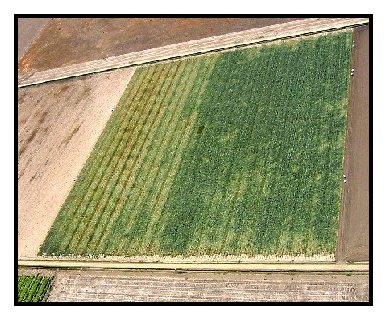 |
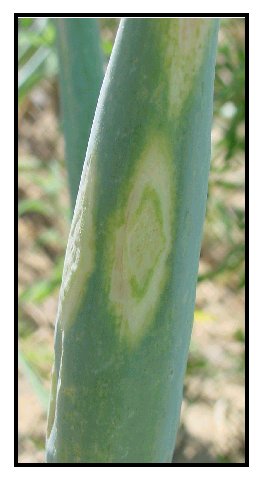 |
Fig. 2. Concentric chlorotic lesion on the scape of a flowering onion plant in a seed crop in the Columbia Basin in July 2004 (photo by L.J. du Toit).
Fig. 3. Spindle-shaped necrotic lesion on the scape of a lodged onion plant in a seed crop in the Columbia Basin in 2004 (photo by L.J. du Toit). |
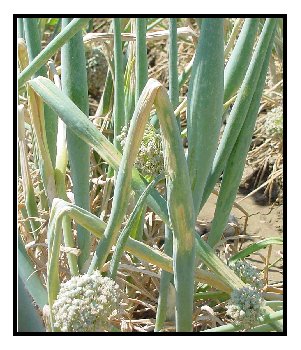 Fig. 4. Lodging in an onion seed crop as a result of severe IYSV infection on the scapes of a seed crop in 2004 (photo by L.J. du Toit). |
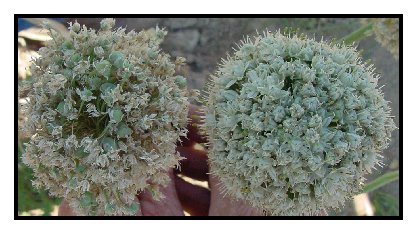 Fig. 5. Limited seed set on an umbel of a plant that lodged as a result of IYSV lesions girdling the scape (left) vs. seed set on the umbel of an asymptomatic plant (right) (photo by L.J. du Toit). |
SOME RECENT VEGETABLE RESEARCH PUBLICATIONS OF WSU VEGETABLE PATHOLOGY TEAM MEMBERS
Fungicide & Nematicide Tests:
- du Toit, L.J.,
Brown, P.R., and Derie, M.L. 2004. Evaluation of Curzate 60DF
for control of downy mildew in table beet and Swiss chard, 2003.
Fungicide & Nematicide Tests 59:V119.
- du Toit, L.J.,
and Derie, M.L. 2004. Evaluation of fungicides for control of
white mold and ring spot in cabbage seed crops, 2002-2003. Fungicide
& Nematicide Tests 59:V118.
- du Toit, L.J.,
Derie, M.L., and Hernandez-Perez, P. 2004. Evaluation of fungicides
for control of leaf spot in spinach seed crops, 2003. Fungicide
& Nematicide Tests 59:V115.
- du Toit, L.J.,
Derie, M.L., and Pelter, G.Q. 2004. Evaluation of fungicides for
control of Botrytis scape blight/umbel blight in an onion seed
crop. 2001-2002. Fungicide & Nematicide Tests 59:V116.
- du Toit, L.J.,
Derie, M.L., and Pelter, G.Q. 2004. Evaluation of fungicides for
control of Botrytis scape blight/umbel blight in onion seed crops.
2002-2003. Fungicide & Nematicide Tests 59:V117.
- Inglis, D.
and Gundersen, B. 2004. Evaluation of seed, and in-furrow and
foliar treatments for control of root rots on peas, 2003. Fungicide
and Nematicide Tests 59:ST020.
- Inglis, D.,
Gundersen, B., and Wickliffe, E. 2004. Evaluation of fungicides,
compost tea and host resistance for control of late blight on
tomato, 2003. Fungicide and Nematicide Tests 59:V076.
- Inglis, D.,
Gundersen, B., and Wickliffe, E. 2004. Evaluation of fungicides
for controlling Ulocladium leaf spot on cucumber, 2003. Fungicide
and Nematcide Tests 59:V073.
- Inglis, D.,
Gundersen, B., and Wickliffe, E. 2004. Evaluation of seed piece
and in-furrow treatments for control of Rhizoctonia on red potato,
2003. Fungicide and Nematicide Tests 59:V074.
- Inglis, D.,
Gundersen, B., and Wickliffe, E. 2004. Use of foliar applications
of phosphorous acid to control late blight on tomato fruit, 2003.
Fungicide and Nematicide Tests 59:V132.
Biological & Cultural Tests:
- du Toit, L.J.,
Miller, T.W., Derie, M.L., Maupin, B.G., Peterson, R.K., and Libbey,
C. 2004. Evaluation of mustard cover/biofumigant crops for management
of Fusarium wilt in spinach seed crops, 2002-2003. Biological
& Cultural Tests 19: V004.
Plant Disease:
- du Toit, L.J.,
Derie, M.L., and Pelter, G.Q. 2004. Botrytis species in
onion seed crops in Washington. Plant Disease: in press.
- du Toit, L.J.,
Pappu, H.R., Druffel, K.L., and Pelter, G.Q. 2004. Iris yellow
spot virus in onion bulb and seed crops in Washington. Plant Disease
88:222.
- Johnson, D.
A., Inglis, D. A., and Miller, J. S. 2004. Control of potato tuber
rots caused by oomycetes with foliar applications of phosphorous
acid. Plant Disease: in press.
- Porter, L.
D., Inglis, D. A., and Johnson, D. A. 200_. Identification and
characterization of resistance to Phytophthora infestans
in commercial potato cultivars and advanced breeding lines of
the Pacific Northwest. Plant Disease: in press.
Abstracts:
- Coyne, C. J.,
Grunwald, N. J., Inglis, D. A., McPhee, K. E., and Pilet-Nayel,
M. L. 2004. Inheritance of Fusarium root rot resistance in pea
using RILs. 5th European Grain Legume Conference, Dijon, France
(Poster Abstract 7-11).
- du Toit, L.J.,
Crowe, F.J., Derie, M.L., Simmons, R.B., and Pelter, G.Q. 2004.
Bacterial blight of carrot seed crops in the Pacific Northwest.
Phytopathology 94:S26 (Abstract).
- Eastwell, K.C.,
Druffel, K.L., and du Toit, L.J. 2004. Etiology of 'black death'
disease of Helleborus spp. 23rd Annual Meeting of the American
Society for Virology, 10-14 July 2004, Montreal, Canada (Abstract).
- Inglis, D.
A., Miller, J. S., and Johnson, D. A. 2004. Efficacy of phosphorus
acid against pink rot and Pythium leak on potato. Phytopathology
94:S44 (Abstract).
- Poplawsky,
A.L., Robles, L., Chun, W., Derie, M.L., du Toit, L.J., Meng,
X.Q., and Gilbertson, R.L. 2004. Identification of a Xanthomonas
pathogen of coriander from Oregon USA. Phytopathology 94:S85 (Abstract).
Book chapters:
- du Toit, L.J.
2004. Management of diseases of seed crops. Pages 675-677, In:
Encyclopedia of Plant and Crop Sciences. R.M. Goodman, Editor.
Marcel Dekker, NY.
- Inglis, D.A. 2004. Management of fungal and Oomycete diseases: Vegetable crops. Pages 681-683, In: Encyclopedia of Plant and Crop Sciences. R.M. Goodman, Editor. Marcel Dekker, NY.
2004 SWEET CORN SEED TREATMENT TRIAL
This article was written by Gary
Q. Pelter, WSU Extension Educator for Grant/Adams Counties.
The International Sweet Corn Development Association conducts a
multi-location seed treatment trial annually. Members of the sweet
corn industry and Gary Pelter have cooperated with the ISCDA in
evaluating seed treatments in the Columbia Basin of Washington for
the past five years. Results from this year's trial are provided
below. There were two seed lots and two center pivot irrigated fields
involved. The lots were selected by ISCDA because they had some
level of seedborne pathogen(s) present. One hundred seed were planted
in each plot, which were organized in a randomized complete block
design. The plots were evaluated by counting emergence at the four-
to five-leaf stage.
Dr. Krishna Mohan of the University of Idaho coordinates this program
and can be contacted for results from other sites in other years.
He can be reached at 208-722-6701 ext. 218 or at kmohan@uidaho.edu.
2004 Sweet Corn Seed Fungicide Trial - Treatments
(click to access doc file)
2004 Sweet Corn Seed Fungicide Trial
- 'July Gold' (click to access doc file)
2004 Sweet Corn Seed Fungicide
Trial – ‘How Sweet It Is’ (click to access doc file)
WSU CARROT CULTIVAR EVALUATIONS
Take a look at the WSU Franklin County Extension website (https://benton-franklin.wsu.edu/agriculture.htm) for a list of publications with the results of carrot cultivar evaluations coordinated by Erik Sorensen in the southern Columbia Basin since the mid-1990s.
2003 COLUMBIA BASIN ONION VARIETAL DEMONSTRATION RESULTS
Gary
Pelter, WSU Extension Educator for Grant/Adams Counties, has carried
out an onion cultivar and storage evaluation trial in the Columbia
Basin annually, to determine the suitability of commercial and experimental
onion cultivars for production in this semi-arid, long-daylength region.
Cultivars are submitted by commercial seed companies for evaluation.
Each year the trial is planted in a grower's onion crop, and maintained
by the grower. The bulbs are then harvested and stored in a commercial
onion storage facility until February of the following year for evaluations.
The links below provide results of the 2003 onion cultivar trial and
storage trial.
2003 Columbia Basin Onion Cultivar Trial (click to access doc file)
2003 Columbia Basin Onion Storage Trial (click to access doc file)
Our pages provide links to external sites for the convenience of users. WSU Extension does not manage these external sites, nor does Extension review, control, or take responsibility for the content of these sites. These external sites do not implicitly or explicitly represent official positions and policies of WSU Extension.

